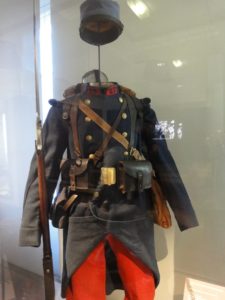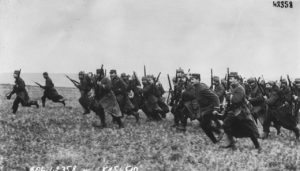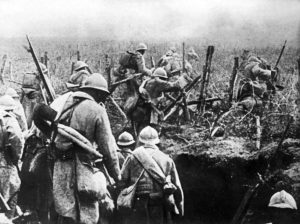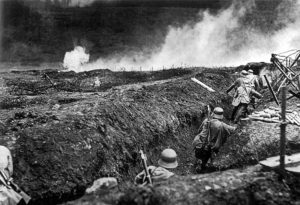Infantrymen entering into World War I could have had little idea about the hell that they were walking into. The opening phases of the war saw outdated models of assault used against modern artillery and machine guns with predictably disastrous effects. Even the uniforms they wore, such as the French with the kepi hats and red trousers made themselves easily distinguishable targets through the smoke and haze of battle, leading to even more unnecessary death. The British and Germans, though they wore uniforms of neutral colors, still went into the war with soft caps, leading to higher death tolls.

Though the uniforms did not help the soldiers’ plight in 1914, it was the tactics used that got them outright slaughtered. All militaries were taught to favor the offensive, that to be aggressive was the best policy that one could pursue (1). The French however espoused this ideology to an extreme extent. In any engagement the most expedient route to victory was to close with the bayonet and fight the enemy hand to hand, valor and élan were believed to be far more important than discretion and firepower. The results of such attacks were hardly surprising. For instance in August, 1914 the French Third and Fourth Armies attacked uphill into prepared German defenses at the Ardennes Plateau. Using neither grenades, nor cover the French were annihilated (2). The message to upper level commanders that infantry tactics would have to change was written in the blood of thousands of young men killed in hopeless charges in the opening weeks of the war.
“My centre is giving way, my right is in retreat: situation excellent. I shall attack”. – General Ferdinand Foch, First Battle of the Marne, September, 1914

As trench warfare ensued, and defensive works became more and more systematic and structured, infantry attacks had to work in coordination with artillery more and more. Friendly artillery would pulverize the enemy trenches, and the infantry would follow up with an attack. They would deploy in skirmish lines, long horizontal lines, with a spatial volume of 1 man per square meter (3) and move across the “no-mans-land”. As the war progressed and the effects of machine gun and artillery fire the formations would become more and more spread out to 1 man per every 3 square meters (4). Once the attack reached the enemy lines the main target would be reaching and eliminating the enemy artillery, thereby facilitating their own reinforcement. It was generally the goal that the forward impetus of the first charge would carry the infantry this far though this was rarely the case (5).

In 1916 at the Battles of Verdun and the Somme, the French and British experimented with different depths and breadths of attack. In general their attacks began to focus on narrower fronts, with the infantry arrayed in far greater depth. They would move forward in individual skirmish lines, men now placed every 5 meters, with each individual skirmish line about 30 meters separate from one another (6). At Verdun the French would attack a front of about 1-1.5 km. in breadth with 12 battalions, in immense depth. They would have designated targets to reach beyond the punctured German line, and as each target was reached the lead battalion would stop to rest as the other battalions pressed onwards (7). It was during these intensive infantry assaults at the Somme that Irishman Robert Quigg won his Victoria Cross.

Despite, innovations in the use of infantry attacks, it was widely recognized that assaulting forces incurred massive casualties. The first day in the Somme Offensive saw the highest casualties incurred by the British in one day, slowly wearing away the public will to fight. The British and French in general sought to use technology to break the enemy defensive lines and follow up with cavalry and infantry attacks through the broken lines. This is how tanks came to be utilized by Allied planners. The Germans however chose to further reform their infantry, and thus through tacticians like Erwin Rommel Assault Squadrons rose to preeminence.

The Germans began using “assault detachments” as early as July, 1915. Armed with grenades, machine guns, minenwerfers, and flamethrowers these elite infantrymen would attack enemy lines immediately following shorter artillery barrages (8). While the majority of the army adhered to a rigid, centralized structure, the assault squadrons decentralized command and gave junior leaders greater freedom to use initiative. Assault squadrons were made up a four-man firing section, armed with a machine gun, and a seven-man maneuver section with lighter weaponry (9). In addition to this squadrons would often work in tandem, one squad laying down suppressive fire as the other moved forward, and then swapping duties as soon a cover was reached (10).

Though the stormtroopers were elite infantry, their task was not to destroy enemy positions. Instead they merely were tasked with opening up enemy lines, getting behind them and creating confusion. Rather than destroy pillboxes or other hard points, they would merely isolate them and allow heavier armed infantry units to deal with them more easily in the successive waves(11). Assault squadrons proved to be the ultimate infantry tool in opening up enemy defensive lines for the more traditional infantry to follow through during the German offensives of 1918 (12).
- Henri Lucas, Pascal Marie, The Evolution of Tactical Ideals in France and Germany during the War of 1914-1918, 1923, pg. 4.
- Marshall, S.L.A., World War I. 1964, pg. 73.
- Lucas, Evolution of Tactical Ideals, pg. 40.
- Balck, William, Development of Tactics- World War, 1922, pg. 69.
- Lucas. Evolution of Tactical Ideals. pg. 45.
- Balck, Development of Tactics, pgs. 69-73.
- Ibid, pg. 81.
- Ibid, pg. 80.
- Zabecki, David T. “Military Developments of World War I .” International Encyclopedia of the First World War.
- Ibid.
- Ibid.
- Balck, Development of Tactics, pg. 271.
